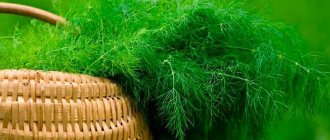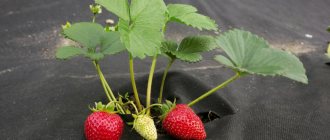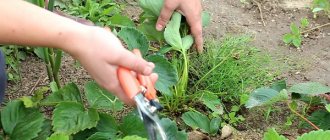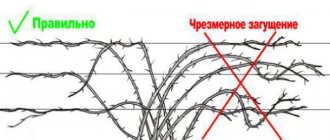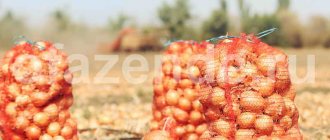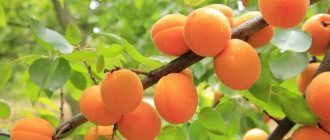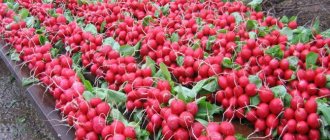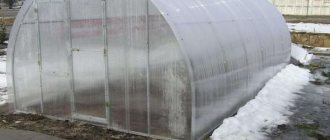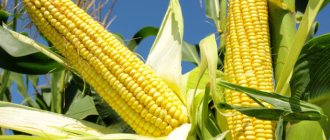Home / Garden / Berries
Back to
Published: 03.01.
Reading time: 5 min
0
63
Sweet hard labor - this is what the gardeners called strawberry beds, until they came to the summer cottages of the technology of growing garden strawberries using agrofibre or film. The unusual method alerted skeptics, but quickly spread among experimental enthusiasts.
When the first positive reviews of under-shelter crops appeared, strawberry agrofibre became a panacea. The advantages of growing plants in beds under black covering material outweighed so much that they no longer reckoned with the disadvantages or learned to minimize the disadvantages.
- 1 Mulching materials 1.1 Organic
- 1.2 Inorganic mulch
- 4.1 Reinforced
- 5.1 Preparation
Process description
There are a lot of methods for growing strawberries themselves. Growing under black cover is a relatively new and definitely effective way to get the desired result. Most often, this method is used in industrial production. For example, Polish farmers are very fond of this method and use it to grow various garden crops. Moreover, the beds are formed and the film is laid with special mechanical devices.
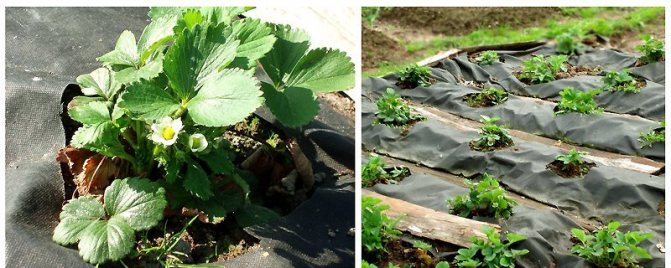
So, a bed of strawberries is covered with a black film, from which leaves of bushes peep out. In other words, the strawberries under the film are in the so-called sauna, where there is no light and no weeds can survive. In addition, the process of watering the planting is facilitated - the coating is able to retain moisture and for 7-10 days the garden bed can not be watered. Also, the strawberries under the film do not come into contact with the soil, so the berries remain clean for a long time and rot from the ground does not affect them. The procedure for cutting the mustache is greatly facilitated, since they are also located above the cover.
The disadvantage of this method can be excessive heat. The black color attracts the sun's rays and the crop dries up. The next significant factor is that you need a drip irrigation system for this method. But on the other hand, thanks to such an irrigation system, you will significantly save water costs. If the above disadvantages are not a problem for you, then let's figure out what we need to plant strawberries under a black film.
> Video "How to plant strawberries correctly"
In this video, you can see recommendations on how to plant strawberries correctly.
What is needed
Of course, the most important material in this method is film. Among professional gardeners, it is called agrofibre or spunbond. She can serve for a long time - about three years. There are several types of agrofibre, but the most effective of all, nevertheless, is black. Due to its color, it absorbs heat, and rapid heating ensures quick harvest.
You can choose a black and white coating - with a dark layer it is directed downward, which ensures warming of the strawberry roots. Light, in turn, is located on top, which is why the plants do not dry out. As mentioned, black or dark brown films are effective, but there is a risk of drying out the strawberries.
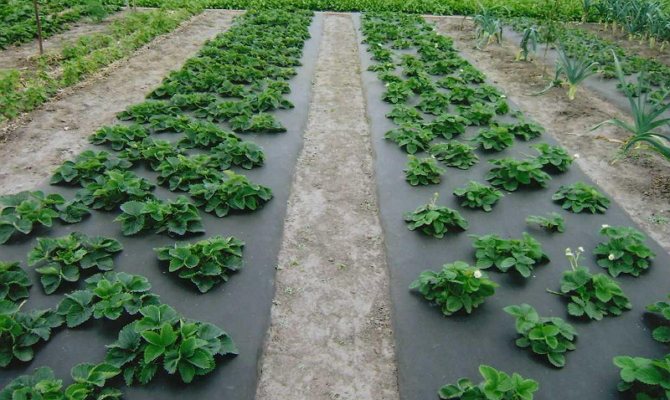

Agrofibre can be bought at any gardening store. The cover is sold with already cut circular holes for plants. The width is usually chosen based on the size of the garden. But the film thickness should not be less than 40 microns. The size of the material depends on the length of the beds and their number.
The second important fixture after coating is the hose. You will need it for drip irrigation of strawberries. The length of the hose should correspond to the length of all the beds (their sum). It is thanks to the installed irrigation system that the planting of strawberries will receive the required amount of water. You will also need scissors, a shovel, ropes, and gardening gloves.
The choice of agrofibre
Covering material can be black or white. The first and second options are successfully used by gardeners in their summer cottages. White agrofibre predominantly shelters beds, shrubs, trees and plants before winter colds, is often used in greenhouses and greenhouses, and is protected from the wind. And they often plant on black material. And why exactly he is so popular we will consider below.
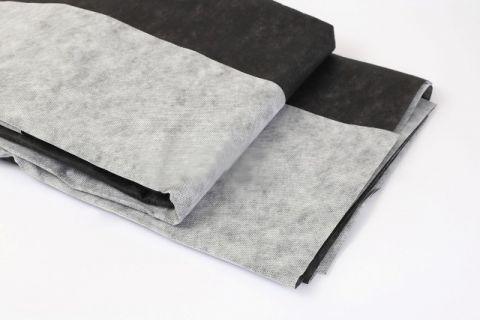

Important! For planting strawberries, it is better to use black agrofibre, it has suitable properties and density. And the recommended density of the material is 50-60 g / m2.
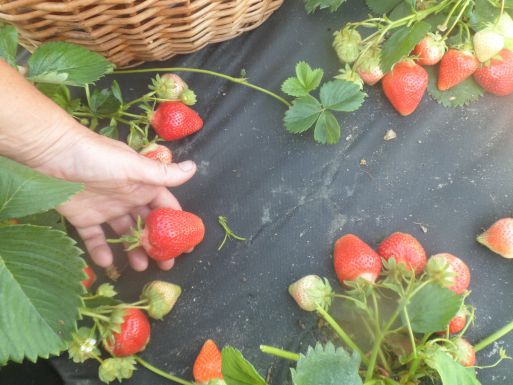

How to plant under the film
First of all, you need to carry out preparatory work on the site. Choose a place where the maximum amount of sunlight falls so that the strawberries under the film will warm up well. It is important that nothing grows at the future strawberry planting site for two to three years. Before planting strawberries, the soil must be dug up and well fertilized.
Be sure to level the soil well, it should not contain large clods of earth. Fertilizers are best used natural. It can be horse manure, humus, compost. As a result, there should be light, loose soil. The garden bed can be about 80–90 cm wide, it is better not to exceed one meter. The convenient distance between the beds is 60–90 cm, then it will be more comfortable for you to monitor and collect strawberries.
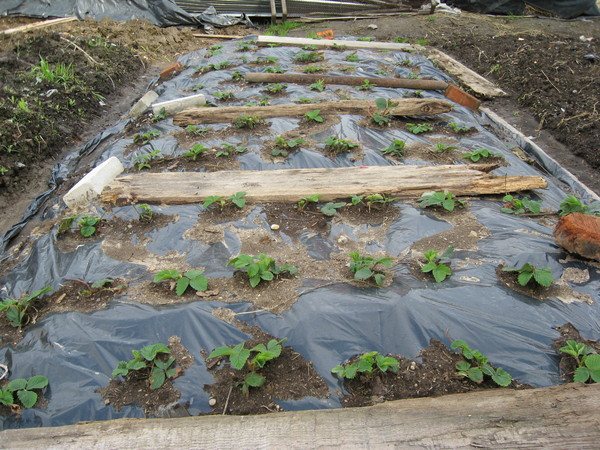

Next, you need to install an irrigation system. We lay a hose between the rows, make small holes in it for water to exit. The hose is sunk into the ground by about 4–6 cm. The remote end of the hose must be closed with a plug.
The next step is to prepare the film. On it you need to make markings, and cut holes for strawberry bushes. It is better to place the bushes in a checkerboard pattern, then they will not interfere with each other's growth. The optimal hole diameter is 10–15 cm. If you don’t want to do painstaking work, you can simply cut the film into two perpendicular lines, and simply hide the remnants of the film inside. The garden should be given time to settle - a maximum of two weeks.
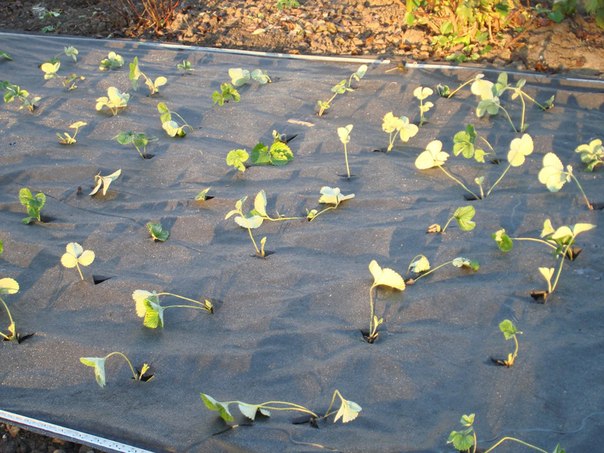

Now we fasten and stretch the cover. To do this, we fix it near the ground, you can bury it with earth from all sides. Use a shovel to make slits where tuck the edges of the film tightly. You can also fix them with bricks or stones.
The final stage is directly planting strawberries. It must be planted in the already made cutouts on the black coating, the excess part of the film must be bent under the canvas. For the first time we water each planted hole with water manually, then the irrigation system will do it.
As you can see, everything is very simple. For this method of growing strawberries, you do not need to spend a lot on expensive tools and devices, all you need is film and the desire to try something new.
> Video "Detailed instructions for planting strawberries"
In this video you can see detailed instructions on how to plant strawberries in black film.
How to properly mulch the soil?
Laying the covering material for high-quality soil mulching is easy to carry out.
Dig up and level the soil.Spread out black mulching material or reflective film-mulch Agrospan BS. Next, make markings on the mulch, thereby indicating the future location of the bushes or seedlings.
The slots for plants can be made cruciform or, using available tools, cut out circles. Make the distance between the slots 40-45 cm, or depending on the characteristics of growing the crop, the main thing is not to plant too close.
Press the edges of the mulch with earth, stones. We put seeds or seedlings into the holes. You can feed the plants in the same slots.
Advantages and disadvantages
The technique of planting strawberries under the film is called "Finnish". With it, you can get clean berries without damage from slugs and other insects in the ground. There are many advantages to using film for planting strawberries:
- There is no need to weed the beds. Weeds do not germinate through the film, so the plantings remain clean throughout the season. Only the “chosen” lucky ones will be able to germinate through the holes next to the strawberry bushes, it is not difficult to remove them. Growing strawberries and care on film is incomparably easier.
- Watering can be done much less frequently. Usually, hoses with perforations are laid under the film, allowing drip irrigation. The covered soil dries out much more slowly, which reduces water consumption when planting strawberries under a film several times.
- The berries do not come into contact with the ground. This protects them from dirt when watering and during rain, as well as from pests. If slugs enter the area, it is much easier to collect them from the film. Diseases that spread to berries from the soil will also remain under the film. Early strawberries under the film always turn out to be very clean and beautiful.
- The mustache does not take root. You can freely remove them, or carefully cut them to expand the plantation. In this regard, strawberry mulching film also makes the work of the gardener easier.
Among the disadvantages is the impossibility or undesirability of planting strawberries under the film in the fall. At this time, manure or other organic matter is introduced into the soil, and the soil is covered with a film to protect it from drying out. It is recommended to plant young bushes on pre-prepared beds either in summer - in early August, or in early spring.
Some are inclined to consider it a disadvantage that it is necessary to purchase film and hoses for drip irrigation. However, these materials serve for more than one year and pay for themselves quite quickly, therefore the number of supporters of the method only increases every year.
The strong and lightweight material has become so firmly established in agricultural use that growers now offer specialized bed formers with strawberry foil stackers to facilitate planting in large areas.
The benefits can be fully appreciated only in practice, because personal experience is always more valuable. And since it is recommended to plant young bushes for the first time on a rested ground (empty for 1-2 years), it is from this garden that it is most convenient to start testing the technique. Even one year is able to demonstrate all the nuances, which will allow you to completely switch to this agricultural technique or abandon it.
Planting seedlings: tips and tricks
You should decide on the type of strawberry seedlings. It comes with a closed (in pots) or open root system (frigo seedlings or just dug out). If the seedlings are in pots, it is convenient to use a film with round holes (if there is no film with holes, you can make them yourself with a wallpaper knife or scissors).
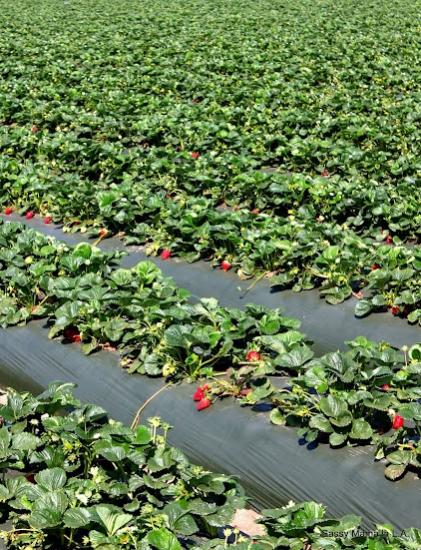

You can make holes in the ground with a pipe having the diameter of a pot. We hammer the pipe into the ground, then pull it out, shake out the ground, and put a strawberry bush together with a lump in the formed hole. It is recommended to make a mark or retainer on the pipe to adhere to the desired hole depth.The order of planting: we make a bed, cover it with black film with ready-made holes, fix the film at the ends of the ridge. Then we make holes in the ground, plant the seedlings. When planting, the main thing to remember is where the drip irrigation tube is located under the film, in order to avoid damaging it.
Planting strawberries without a pot on mulch film is more difficult. The holes in the film are made with a knife, not necessarily round, but cruciform. Then the roots of the seedling are tucked neatly into the ground into the prepared hole.
We make the ridges of arbitrary length, the width depends on the number of rows. There is a distance of at least 40 cm between the ridges. Some gardeners put straw on the film, this does not allow the roots of plants to overheat. The berry in such a shelter will be clean, without weeds, and will not be affected by diseases. Strawberries planted in this way do not require weeding, loosening, frequent watering, whiskers do not take root, they are easy to cut.
The beds should be raised so that when it rains, the water can drain freely and does not form puddles.
At the end of fruiting, the film is removed, dried and rolled into a roll until next year. The straw is collected. Old and diseased leaves are removed from strawberries, treated with drugs for diseases or a solution of potassium permanganate.
How to choose a film
On sale there are several types of films used to cover the beds:
- Black and black-and-white film for strawberries, 40-50 microns thick. It can be purchased in specialized shops for gardeners, as well as in construction shops. The material is quite versatile, it is sold in rolls of various widths. Black is not chosen by chance, since it heats up more than any other in the sun. Better to choose black and white. Such a film is laid with the black side down and the white side up. The black bottom warms up the soil well and prevents weeds from growing. The white top does not overheat in the sun and does not burn the strawberry leaves in too hot weather.
- Foil with pre-drilled holes for planting strawberries. It is a completely ready-to-use material. If you still have to tinker with ordinary film, cutting holes for bushes, then here the manufacturer has already taken care of the high accuracy of the distances between individual holes in rows and aisles.
- Mulching film for strawberries with perforations of more than 60 microns is guaranteed to last for several years. This is very convenient, because strawberries can grow in one place for several years, after which they are completely removed. At the end of the season, the film is inspected for damage, after which the remaining intact and undamaged strips can be reused.
Most often, a film for strawberries from weeds with a width of 1.6 or 3.2 m is used. The second option is cut lengthwise into two strips, but you can also form a wide ridge if desired. The width of a standard bed is 1 m, and the remaining overlaps are used to secure the film from being blown away by the wind.
Types that can be used for mulching
Many color solutions of films of different densities are widely available on sale. Black agrofiber reads high-strength shelter to protect the plant from aggressive environmental influences. The nonwoven fabric contains no toxins and allergens.
- Proven over the years black polyethylene sold in sleeves and rolls. Polyethylene thickness from 0.03 to 0.4 mm. The film copes well with the task, but its strength is enough for 1 season.
- Non-woven black fabric - an excellent alternative to fragile polyethylene. Externally, the materials have similarities, differences in composition and method of production. It can also be called spunbond.
- Produced made of polypropylene fibers, under the influence of high temperatures, the film is in demand in organic farming, it is called agrofiber. It must be laid on the right side.
In recent years, gardeners have preferred mulching and covering strawberry beds with black film. 100% ecological covering material will protect from the hot sun rays. With agrofibre, you can cover plants and get rid of weeds. The strawberries will be provided with favorable conditions for growth.
How to properly plant strawberries under a black film (step by step method)
The sequence of planting strawberries under the film looks like this:
- Soil preparation. Before planting strawberries on a black film, prepare the soil. It must be carefully dug up, loosened, enriched with humus or organic matter. If the soil is too heavy, loamy, then some sand is added to it to improve aeration. These works are carried out in the fall so that young seedlings can be planted in the spring.
- Marking of future beds. Planting strawberries is carried out on average with row spacings from 50 cm, and the distance between individual plants in a row is from 35 cm. You can bring two ridges closer together, but then there should be free aisles on both sides of them.
- Stretching out the watering hoses. It is better to dig them in to a shallow depth along the planting line, stepping back a little to the side. So, the water will flow exactly where it is needed, without spreading to the sides of the plantings.
- Lining the beds. It all depends on how you decided to fix the film. You can press it along the ends with metal pins, breaking through the previously prepared squares of linoleum or foam. They use digging in narrow trenches along the beds, as well as any weighting materials available to the gardener.
- Planting strawberries under the film. If the material is perforated, then just fill the holes with seedlings. If there are no holes, then we outline the locations of the holes using a measuring tape or a previously prepared standard (sticks 35 cm long or more). Cross-shaped cuts are made with a sharp knife. The edges fold inward. You should get holes with a diameter of about 15 cm - no more.
- The first watering is done immediately, and the subsequent ones will be required at intervals of 1 time per week - not more often. If in a given area it rains all summer and spring with a stable regularity, then artificial watering may not be required at all.
At this point, the process of leaving can be considered completed. Watering with periodic additions of fertilizers, timely collection of ripe berries is all that needs to be done on the site. When the time comes (August), the strongest of the mustaches left are cut off for rooting in the selected bed.
When wondering how to plant strawberries in the fall under a black film, it is worth considering that plants need some time to root in a new place. On average, a single bush takes about 2 months to develop a healthy and strong root ball. If this work is carried out in August, then there will be quite enough time. Later, there is much less heat and sun, which means there is a great risk of losing all seedlings after the very first severe frosts.
High-quality covering material serves for more than one season. If you walk on the film in soft shoes or barefoot, then he is not at all in danger of damage. Having spent one time on all the beds, in the future you can transfer the film as the plantations move from one place to another. Such material does not cause any damage to the ecology of a summer cottage or agricultural land.
Preparing the beds for planting using a covering material
The process of preparing a bed for planting strawberries is as follows:
- First you have to prepare the ground - dig up a bed, remove weeds and apply organic fertilizers.
- The beds should be raised, double-leaf, so it will be easier to fix the canvas.
- Spread the covering material neatly on top of the prepared bed. Fasten edges firmly... Sandbags or DIY hairpins are best suited for this purpose.
- Place the fabric with the waterproof side up.
- In order for the bushes to grow evenly, you can take a cord to mark the holes, which must be pulled in a straight line over the entire length of the garden.
- Make holes for bushes at a distance 25 cm., between rows - 40 cm.
- After the covered bed is prepared, you can plant strawberry seedlings.
What gives the use of film when growing strawberries
Pros of using black film
Black film on beds with garden strawberries allows you to solve a number of problems of growing these berries.
- Weeds do not have the ability to germinate under the black cover material. Seeds carried by the wind cannot penetrate the ground. Those that are below, slightly germinate, but the absence of chlorophyll prevents the development of full-fledged plants. The pale sprouts soon become malnourished and die. Especially effective for perennial weeds, they are depleted of food reserves. After a year, they turn out to be unviable.
- The berries, being on the surface of the covering material, do not come into contact with the soil. There are no soil fragments on them. The incoming moisture flows down and does not remain on the crop. Therefore, the quality of the resulting crop is much higher than that obtained using traditional cultivation technology.
- The time to get the first harvest is getting shorter. The reason is simple: the soil under the black covering film warms up faster, flowers and ovary appear earlier than in standard beds.
- The moisture in the soil lasts longer. Evaporated in the heat, it remains under the film. Condensation occurs there. Even in extreme heat, the soil does not overheat. Bushes, where there is a film cover of the soil, remain fresh and fruitful.
- Frosts do not pose a danger to garden strawberry bushes. The root part is protected from freezing during the night.
- The film is produced on the territory of the state. The technology has been worked out, so its cost is low. In a short time, all berry plantations can be covered with effective material.
- These advantages are characteristic only for black film. She should not let sunlight through her. Ultraviolet rays penetrate under the light covering material.
- Mustache, from the bushes can not find a place to root. The grower can organize the propagation of strawberries only from the first antennae, cutting off all the others. Small cups with soil are used, where new plants are rooted.
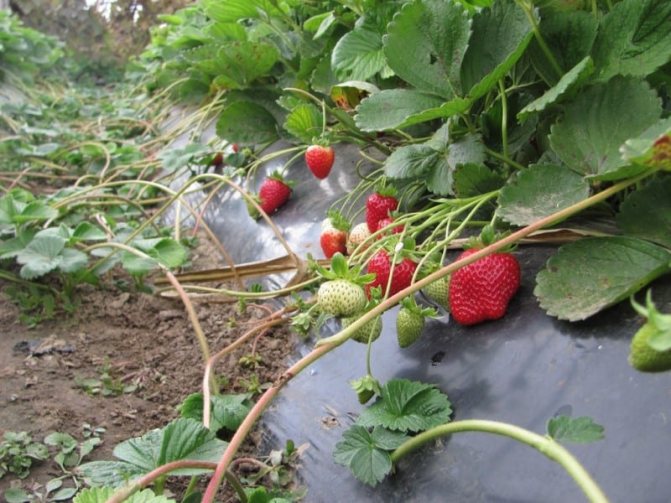

Disadvantages of black film
Despite the many positive indicators of the use of the film, certain disadvantages can also be noted.
- Black polyethylene is destroyed by ultraviolet rays. It is enough for more than two seasons of operation. Therefore, you need to purchase fiber, for example, lutrasil. This is a fabric designed for long-term use.
- Polyethylene does not allow moisture to pass through, so a lot of steam is generated on hot days. The enthalpy of humid air is quite high; heat transfer at night does not always provide cooling. This leads to a loss of sugar. Attention! Sweet berries are obtained if the temperature difference between day and night reaches 7 ... 10 ⁰С. The use of a nonwoven fabric eliminates this disadvantage.
- Watering outside is difficult. Therefore, in the beds where garden strawberries are grown, it is advisable to install drip irrigation systems. Only in this case the optimal heat and humidity balance under the shelter will be maintained.
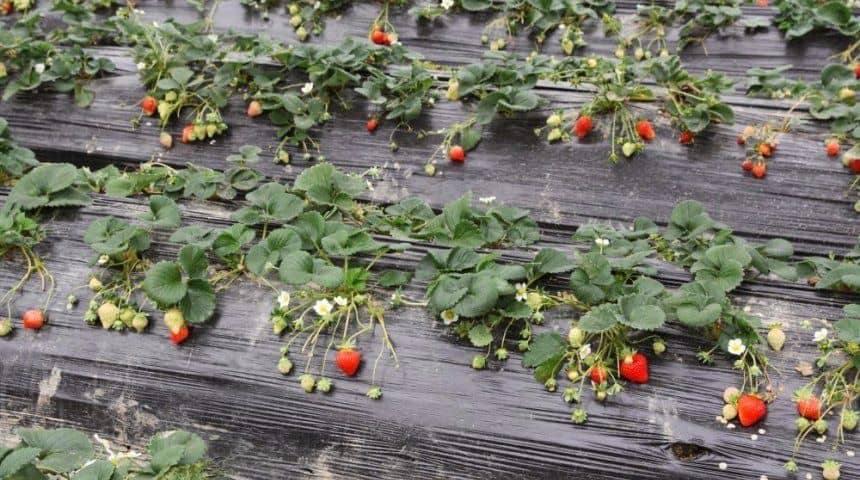

The advantages of such a landing
- The black non-woven fabric makes an excellent mulch, you don't have to constantly pull out weeds.
- The material retains moisture well. Strawberry is a thermophilic plant, but drying out leads to sad results. Therefore, the black material is ideal for retaining moisture.
- Moisture and air perfectly pass through the material.
- Useful earthworms like to settle under the material.
- Mulch does not rot.
- The berries ripen faster.
How to start the transition to growing strawberries on black film
If the cultivation is carried out according to traditional methods, then you need to consistently carry out the main activities in order to transfer the strawberry beds to a promising technology.
Creating a fenced high bed
In the media, you can find recommendations for growing strawberries in ordinary beds, only covered with black covering material. But incomplete transition to advanced technical solutions will not allow you to fully experience the benefits.
We need high fenced beds.
- The presence of the sides prevents the soil from falling on the paths between the rows where the plants grow.
- Processing is carried out only inside the fence, the paths remain in place for many years. They are laid out with tiles or bricks. Then you can move in the garden without fear of getting your shoes dirty.
- The sides are raised, the soil is also higher. The gardener does not need to bend low while doing the job.
- The beds are located in one place. Easy to organize crop rotation. Only the specified crops are grown at a specific location.
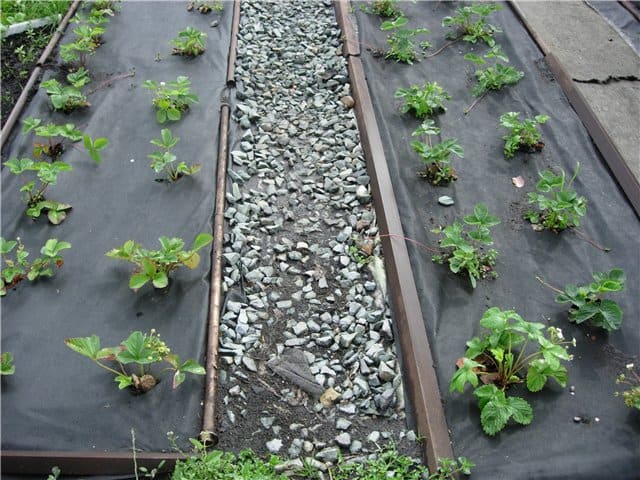

To create such structures, do the following.
- In place of future ridges, a trench is dug 0.4 m deep and 0.4 ... 0.5 m wide.
- With the help of pegs and twine, markings are made.
- Install the sides. Practice shows that preference should be given to asbestos-cement sheets. They are not afraid of moisture, they are not subject to decay. They can be painted. Pre-sawn sheets 40 cm long, 20 cm buried in the ground. There is still 20 cm above the ground.
- The trench inside the garden bed is filled with organic waste. Preferably arboreal: branches, stem fragments, bark, etc.
- The resulting structures are covered with garden soil. You can add humus and peat.
- Paths are laid between the beds.
The optimum width is 0.6 ... 0.8 m. A person of average height easily reaches the middle of the ridge. The length should be easy to service.
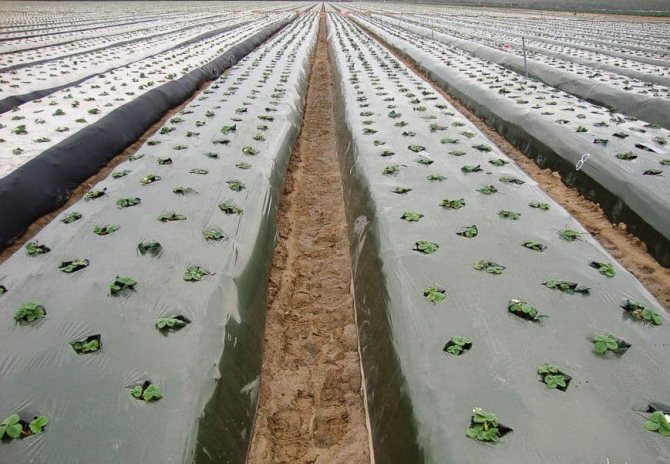

Preparing a bed for planting strawberries
Strawberries prefer loose soil. There should be enough food in it. The presence of humus only improves the growth condition of the bushes.
- It is advisable to fill the beds with organic matter. Manure is laid to a depth of 30 ... 35 cm. Dry manure of cattle, rabbits, sheep (goats) is suitable here. Within two to three years, it will feed the roots. In strawberries, they do not go deep into the ground, but spread to a depth of 12 ... 15 cm.
- To make it easier to water in the future, a metal-plastic pipe with a diameter of 15 mm is laid on the garden bed.
- The strawberries will be planted in two rows. The distance between plants in a row will be 30 cm. Therefore, holes with a diameter of 0.5 ... 0.7 mm are drilled in the pipelines.
- The ends of the pipes are clogged with wooden plugs, they swell and do not allow moisture to pass through.
- At one end of the bed, an irrigation container is installed.
- It is installed at a low height. Attached with a crane. With its help, the degree of opening is regulated.
Garden strawberries are planted in late August or early September.
Rosettes are used for planting (strawberry sprouts of this season). They must have roots for planting in the ground.
- The bed is covered with a film. The optimum thickness is 40 ... 60 microns.
- It is fixed to the sides of the bed with the help of clerical clamps. It is allowed to simply lay with heavy objects.
- The excess film is cut off. Leave no more than 10 ... 15 cm on each side.
- In places where the drip irrigation pipelines have holes, the covering material is cut crosswise. The length of the cuts is about 5 ... 7 cm.
- The slits are opened.
- They dig holes in them. Depth 10 ... 15 cm, diameter 3 ... 5 cm
- Spill water and plant the plants. For each bush poured 0.5 ... 1.0 liters.
- Slightly crush the soil.
- To prevent the cuts from opening, the ends are pinned with aluminum staples.
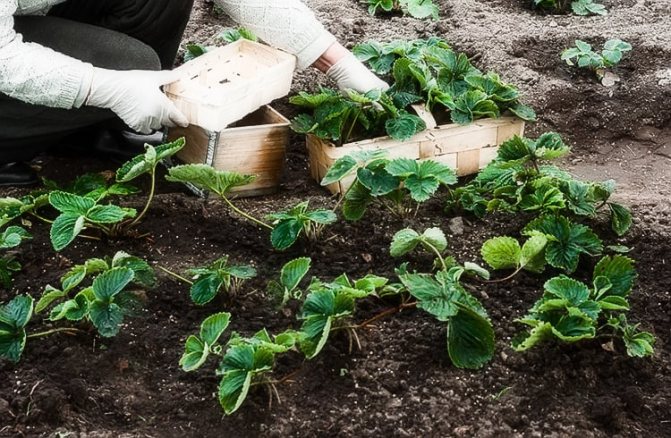

Features of caring for a bed covered with black film
Autumn care is reduced only by periodic watering.For the winter, the garden bed can be covered with leaves, hay, straw or agrospam.
With the onset of warm days, the insulating shelter is removed.
The first watering in April can be accompanied by top dressing. Mineral fertilizers are dissolved in the container. The quantity is determined per plant:
- 3 ... 4 g of urea;
- 2 ... 3 g of double superphosphate or 4 ... 6 g of simple superphosphate;
- 1 ... 2 g of potassium nitrate.
Re-feeding is done every 18 ... 25 days.
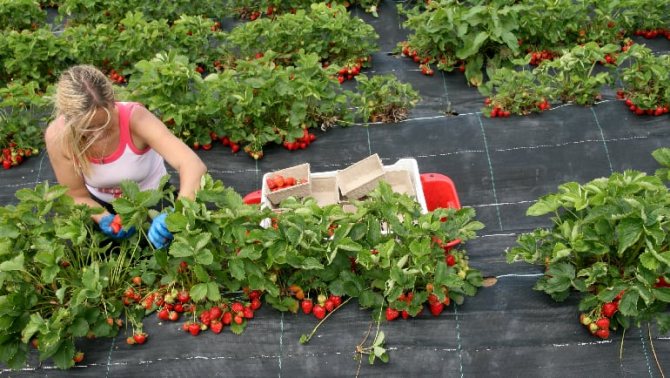

Frost protection
For the early spring period, it is advisable to install arcs over the beds. Covering material is pulled over them. A positive temperature remains under it.
The sheltered strawberry beds are not cooled at night. During the day they are opened, allowing bees and bumblebees to pollinate the flowers.
The use of additional shelters allows you to get the first berries in the second decade of May, and in the southern regions they begin to feast on strawberries on the May holidays.
- Growing strawberries on a black covering film allows you to get a high yield of high-quality berries. They are not damaged by pests, rot does not spoil the crop.
- Weeds do not develop under the black film. Even perennial weed vegetation becomes unviable during the year. After two to three years of cultivation, the soil completely gets rid of unnecessary plants.
- The soil in the beds with black covering material is kept moist for a longer period. Water consumption for irrigation is reduced by two to three times.
- It is advisable to arrange covered black beds for growing strawberries on high ridges bounded by boards. Part of the fence is deepened by 20 cm. Another 20 cm remain above the soil level.
- For irrigation, it is necessary to create a drip irrigation system. In the process of water supply, plants are fed, after having dissolved mineral fertilizers in water.
- In the spring, to prevent hypothermia, arches are installed over the plants and they are covered with a cloth.
Film for strawberries
Other covering materials
Mulching strawberries can be done using:
- straw;
- dry grass;
- sawdust;
- cardboard;
- Spanboda;
- roofing material.
Wheat or rye straw must first be shaken, moistened and dried in the sun. Laying the mulch is done in a thick, even layer of about 7 cm.
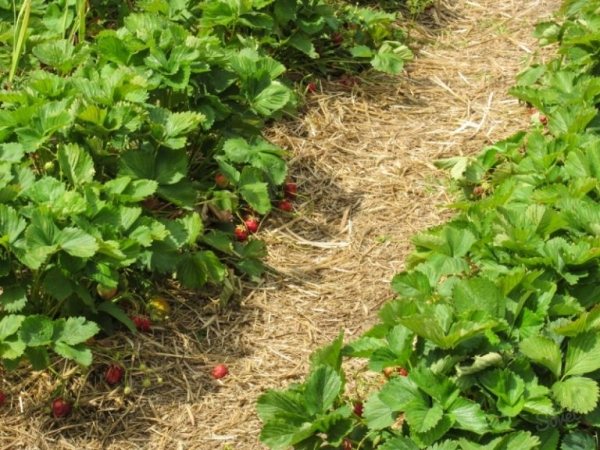

Dry grass is laid out between the rows in a 5 cm layer. Thanks to the mown grass, the berries do not lie on the ground, which does not dry out.
The soil structure is favorably influenced by the introduction of sawdust. However, this method is not suitable for acidic soils, because the material increases the acidity, which makes the berries smaller.
If the site is susceptible to pest infestations, there will be more of them, as the conditions under the sawdust become favorable for insects.
Roofing material is a dense coating that is absolutely not dangerous for the plant, does not emit harmful impurities. This material covers the ground, which is pre-enriched with humus. The service life is 3 years.
Another mulching material is Spunbond covering fabric. It allows moisture to pass through well and keeps water from rapid evaporation. Spandbond will last for 2 years.
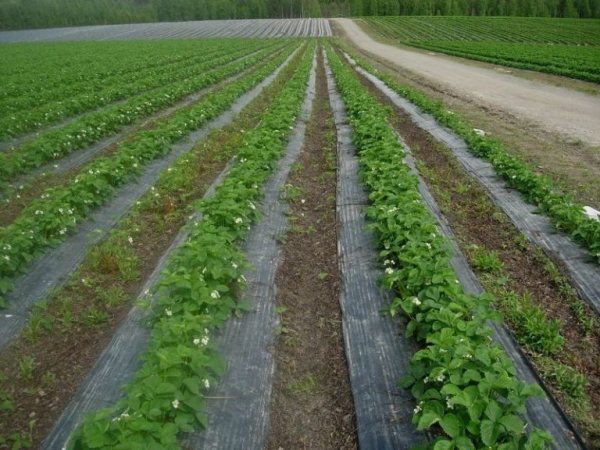

Cardboard and old newspapers are also suitable for mulching. To do this, you need to prepare a bed for planting strawberries and cover with this material. It should be laid in such a way that the sheets overlap each other by 20 cm. The ground must be completely covered, as this will prevent the weeds from germinating. Using large sheets of cardboard to mulch the strawberries is ideal because there will be fewer joints.


